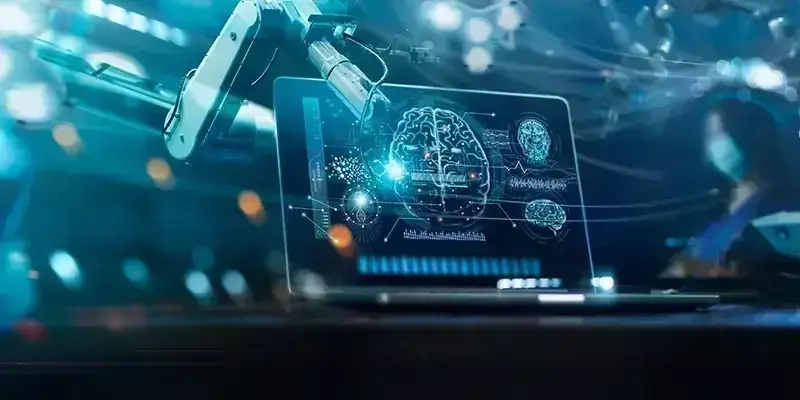

Teleradiology
Advances In Neuroradiology
Introduction
Magnetic resonance imaging (MRI) is well-established in neuroimaging due to its relative abundance, non-invasive, and free from ionising radiation ability. MRI can detect both brain perfusion and metabolic activity and hence plays a vital role in neuroimaging. It can help in identifying both congenital and degenerative disease processes in the brain. The advances in neuroradiology are constantly evolving from sequence modifications and inventions to data analysis. It can enable various neuro-imaging technologies such as anatomical images and functional and quantitative data for diffusion-weighted imaging (DWI), spectroscopy, blood oxygenation level-dependent functional MRI, and T1/T2 mapping dynamic contrast-enhanced imaging.
A few recent trends in medical imaging have been elaborated on here.
Volumetric MRI
T1-weighted MR imaging has increased sensitivity to assess epileptogenic lesions. The Hallmark of Temporal lobe epilepsy (TLE) is hippocampal volume loss, signal changes ad loss of internal architecture. There may be artificial smoothing during the initial processing of 3T MRI, which can be more accurately assessed by increasing the spatial resolution to 7T imaging. [1] Volumetric MRI in Huntington’s disease is characterised by a reduction in regional brain volume that correlates to disease characteristics. Even before the onset of motor symptoms volume loss is seen in the caudate and putamen, whereas loss in cortical regions is more widespread and may be seen after clinical motor diagnosis.
Diffusion-weighted imaging
Diffusion-weighted MRI (DW-MRI) deploys a magnetic field that sensitises MRI signals to characterise cell sizes, density, and morphology. The diffusion tensor imaging (DTI) signal model is sensitive to macro and microstructural tissue. The diffusion kurtosis imaging (DKI) signal model provides more sensitive and accurate information about tissue microstructure when compared to DTI. The Composite hindered and restricted model of diffusion (CHARMED) is a multi-compartment model that is helpful to know the axonal density and extra-axonal diffusion tensor. The orientation dispersion index, neurite density index, and isotropic volume fraction can be known by neurite orientation dispersion and density imaging (NODDI). Microstructural measures and more sensitive than DTI indices as they provide additional information and more accurate and powerful biomarkers of tissue disease burden in multiple sclerosis. NODDI metrics are found to be associated with cognition in Alzheimer disease in the early stages. DKI can enable distinguishing gliomas from other intra-axial brain tumors. It can differentiate between high and low-grade gliomas with a sensitivity of 0.87.
EEG-fMRI
EEG-fMRI can help in the localisation of epileptic foci as EEG can identify brain activity associated with interictal epileptiform discharges which also increase metabolism and blood flow that can be measured by BOLD signal. Therefore, it can identify the foci and how they propagate. It also finds its application in the pre-surgical evaluation of patients with drug-resistant focal epilepsy. EEG-fMRI can also explore cognitive deficits in epilepsy.
Whole brain spectroscopy
Whole-Head Proton MR Spectroscopy (WH-MRS) enables picking up signals that can be used as surrogate markers in diffuse neurological pathologies. N-acetyl aspartate, creatinine, and choline signals are excluded from the brain.
Multinuclear MR spectroscopy
Magnetic resonance spectroscopy of the central nervous system offers the advantage of non-invasive and non-ionising evaluation of tissue concentrations and metabolic turn-over rates of more than 20 metabolites and compounds.
DTI-ALPS
Diffusion tensor imaging along with the perivascular space (DTI-ALPS) parameters can be a biomarker for glymphatic activity in Alzheimer’s disease.
Magnetoencephalogram
MEG offers a superior electrophysiological imaging technique that measures postsynaptic potentials to provide a broader and more spatially precise assessment of the entire brain. Pre-surgical MEG evaluation of epilepsy can be an important clinical tool by detecting unique magnetic signatures of epileptiform spikes. MEG can detect aberrant network connectivity in Temporal lobe seizures.
Non-contrast arterial spin labelling MR perfusion
Arterial spin labelling (ASL) perfusion magnetic resonance imaging (MRI) sequence enables visualisation of cerebral blood flow (CBF) without the need for any contrast and can be done with a structural MRI. Evaluation of cerebrovascular diseases such as arterio-occlusive disease, vascular shunts, assessment of primary and secondary malignancy, and as a biomarker for neuronal metabolism in seizure and neurodegeneration.
7 T MRI
Conventional magnetic field strengths (1.5 and 3T), only 60%-85% of MRIs reveal structural brain lesions responsible for epilepsy. This is the critical factor as it can assure freedom from seizures after surgery in those with drug-resistant focal onset epilepsy, which forms 30%-40% of all epilepsy cases. Success higher than 2.5-3 times can be assured if epileptogenic lesions are identified. Vascular malformations especially venous malformations are observed better with 7T MRI. 7T fMRI help with better presurgical planning as they enable improved localisation. MR spectroscopy at 7T not only increases spatial resolution but also increased the spectral resolution of UHF.
Conclusion
Neuroimaging and interventional neuroradiology have undergone significant advancement with advanced imaging techniques in MRI, PET, MEG have opened opportunities for a better understanding of neurological conditions. Several clinical indications for the use of 7T MRI in clinical practice and approval for use in diagnostic purposes have become a global reality.
More from AMI
What is Diagnostic Radiology? Understanding its Tests and Procedures
14/08/2023
Emerging Techniques in Radiology By Dr. Namita
10/11/2022
How Aster Medical Imaging’s Nighthawk Service Enhances Brain Neuroimaging
29/09/2025
Imaging In Pregnancy
18/01/2023
How Teleradiology Solutions Help Hospitals Cut Turnaround Time
20/08/2025
Sports-Related Injuries and the Importance of Radiology
30/01/2023
Empowering Radiologists-Teleradiology Redefines the Role of Imaging Specialist
09/10/2023
Behind The Scenes of Teleradiology: How Digital Imaging Is Changing Diagnostic Medicine
16/10/2023
Emerging Trends and Technologies in Medical Imaging
19/06/2023
Improvement of Patient Care Through Teleradiology
03/07/2023
Why Hospitals Prefer Teleradiology Outsourcing for Accurate and Timely MSK Injury Reports
14/11/2025
How to Choose a Prospective Teleradiology Service Provider
07/08/2023
10 Strategies To Prevent Burnout In Radiology
09/01/2023
Unlocking the Knee: How Tele-Reporting Service Empowers Clinicians
25/11/2025
Imaging Instrumentation Trends In Clinical Oncology
26/06/2023
Teleradiology's Contribution to Timely Emergency Diagnoses
04/10/2023
Scope of Radiologist in India
29/08/2023
How Teleradiology Supports Musculoskeletal Pain Specialists in Diagnosis
20/08/2025
The Future of MRI: Advancements and AI Integration in Online MRI Reporting
19/05/2025
Cardiovascular Imaging: Expanding Access to Advanced Heart Care with Teleradiology
29/09/2025
Revolutionizing Indian Healthcare: Unlocking the Potential of Teleradiology in Remote Areas
27/09/2023
MRI Spine Thoracic: How Teleradiology Enhances Faster, Accurate Diagnosis
29/09/2025
How to Increase the Efficiency of the Radiology Equipment
21/08/2023
Intra- Operative 3D Imaging With O- Arm Making Complex Spine Surgeries Safe and Accurate
30/11/2022
How Teleradiology Reporting Services Are Revolutionizing Frozen Shoulder Diagnosis and Reporting
17/11/2025
Radiology Online Reporting: Transforming Diagnosis with Speed and Accuracy
31/07/2025
Radiology Practices
30/11/2022

AMI Expertise - When You Need It, Where You Need It.
Partner With Us
